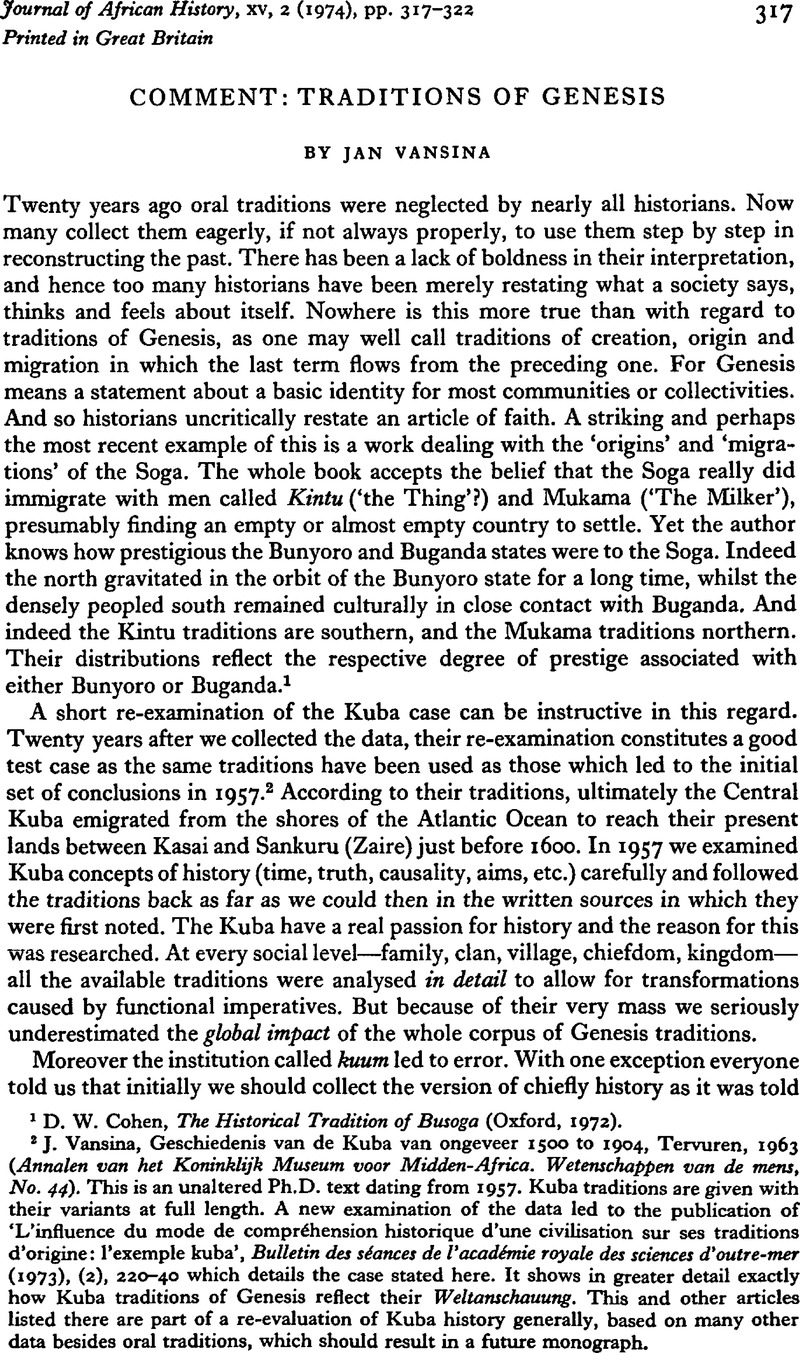Article contents
Comment: Traditions of Genesis
Published online by Cambridge University Press: 22 January 2009
Abstract

- Type
- Comment
- Information
- Copyright
- Copyright © Cambridge University Press 1974
References
1 Cohen, D. W., The Historical Tradition of Busoga (Oxford, 1972).Google Scholar
2 Vansina, J., Geschiedenis van de Kuba van ongeveer 1500 to 1904, Tervuren, 1963 (Annalen van het Koninklijk Museum voor Midden-Africa. Wetenschappen van de mens, No. 44). This is an unaltered Ph.D. text dating from 1957. Kuba traditions are given with their variants at full length. A new examination of the data led to the publication of ‘L'influence du mode de compréhension historique d'une civilisation sur ses traditions d'origine: l'exemple kuba’, Bulletin des séance: de l'académie royale des sciences d'outre-mer (1973), (2), 220–40 which details the case stated here. It shows in greater detail exactly how Kuba traditions of Genesis reflect their Weltanschauung. This and other articles listed there are part of a re-evaluation of Kuba history generally, based on many other data besides oral traditions, which should result in a future monograph.Google Scholar
3 Miller, J. C., ‘Kings and Kinsmen: The Imbangala Impact on the Mbundu of Angola (Ph.D., University of Wisconsin, 1971).Google Scholar
4 Sheppard, W. H., Presbyterian Pioneers in Congo, Richmond no date (Evidence from 1892), 114. (Reprinted in Four Presbyterian Pioneers, no place, no date.)Google Scholar
5 Tradition attests Kuba trade with the Lower Kasai by the eighteenth century. Moreover an examination of market terminology reveals that the Kwilu—Kwango area was linked with the Stanley Pool region and formerly probably with Okanga on the lower Kwango. F. Bontinck, Histoire du royaume du Congo (c. 1624) (Etudes d'histoire africaine IV) (1972), 133, translates a text, stating that a Rafael de Castro went 200 miles beyond Okanga around 1620. From comparative distances in the same text this would have brought him perhaps as far as the Loango river and certainly into the territory from where the last Kuba dynasty originated around 1625. Such a long trip could likely only have been accomplished along an existing trade route.
6 Cf. Vansina, J., ‘Geschiedenis…’, p. 110.Google Scholar
7 Cf. note 4, p. 318. Sheppard noted this already.
8 Hence a weighty reason for rejecting migration routes proposed by E. Boelaert, Kuba en Mongo (ms.) and G. Van Der Kerken, L'ethnie mongo, Bruxelles 1944 (Mem. in 80; Institut Royal Colonial Beige. Section des sciences morales et politiques, XIII, 2 vols.)
9 Wrigley, C., ‘Rukidi’, Africa, XLIII, 3 (1973), 219–34.CrossRefGoogle Scholar
10 Beidelman, T. O., ‘Myth, Legend and Oral History: A Kaguru Traditional Text’, Anthropos, LXV (1970), 74–97.Google Scholar
11 De Heusch, L., Le roi ivre (Paris, 1972).Google Scholar
12 Cf. note 9, p. 320.
- 15
- Cited by




